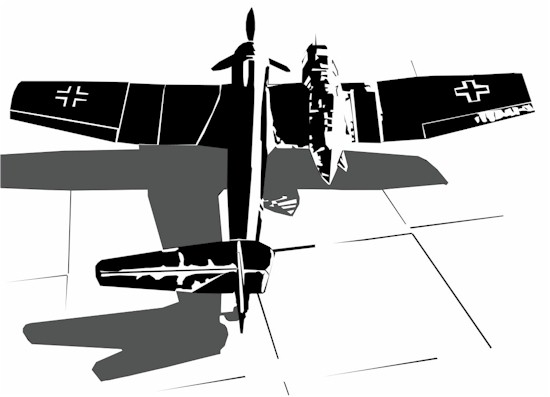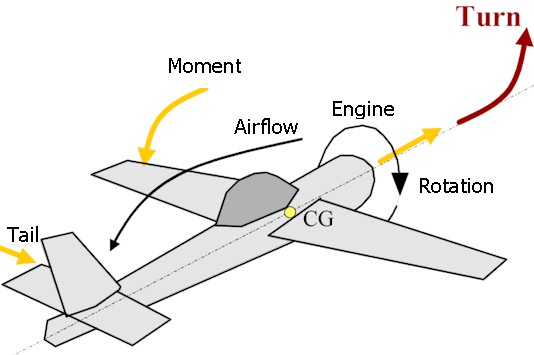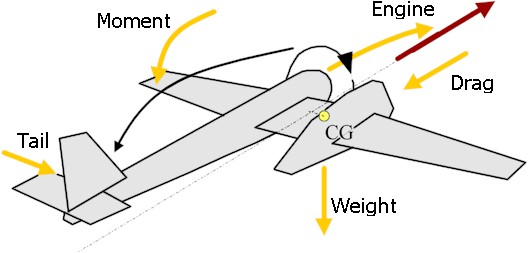 |
|||||||||||||||||||||||||||||||||||||||||||||
|
|||||||||||||||||||||||||||||||||||||||||||||
|
The specifications were sent by RLM to Arado and
Focke-Wulf. Dr.-Ing. Richard Vogt had an unusual idea about all-round view
and single engines and made a private-venture proposal. Its name was BV
141. His idea was to place the fuselage and the engine off
center. When you look at the drawing of the airplane, you probably will
react with "Huh?". Yes, it looks strange. You might think that
this airplane will not be stable in flight. Sorry, you are wrong. It was
even a very stable airplane. In fact, it was even more stable than the
"normal" single engine airplanes. |
|||||||||||||||||||||||||||||||||||||||||||||
|
|||||||||||||||||||||||||||||||||||||||||||||
| To understand this you need to look at the following
drawings. There you will see what forces are created in a conventional
single engine airplane and how the design of Blohm und Voss became more
stable. |
|||||||||||||||||||||||||||||||||||||||||||||
|
Forces on a conventional airplane |
|||||||||||||||||||||||||||||||||||||||||||||
Forces on the BV 141 |
|||||||||||||||||||||||||||||||||||||||||||||
| The plane flew well. Even the critics had to admit
that. But the project had some troubles. There were some belly landings
due to failure of the hydraulic system, which operates the landing gear.
This and the desire to ensure the production of the Focke-Wulf Fw 200
Condor (which took place on 80% of the assembly shop space at Blohm und
Voss after a bombing raid on the Focke-Wulf plant) made the RLM choose the
reliable Focke-Wulf Fw 189. The Fw 189 was a surprise to the RLM, because it had two engines. The specification, made by the RLM, did not mention that the total power had to be delivered by one engine. But everybody, except Focke-Wulf, didn’t consider the choice of two engines. It is my idea that the RLM made a right choice here due the unreliability of the BV 141. The Fw 189 proved to be an excellent airplane. It is still one of my favorite "normal" airplanes.
You
will see that the engine in the data is more powerful than the
specification mentioned in this page. The reason for that is that in the
development of the BV 141 more power was needed. Luckily Dr.-Ing. Richard
Vogt had foreseen this demand and made the original design accessible for
larger engines. In my books I found an article about a similar design, the Da-U.
It is a design of prof.-ing.-doctor M. L. Tudha (university of Grönfeldesz).
It is a double engine airplane. But here the two engines are placed behind
each other. One engine drives a tractor prop, the other a pusher prop.
Both engines are placed in the same "nacelle" (don’t know if
this is the right word) on the right of the fuselage. It has the advance
that the door on the left of the fuselage is totally free from the props.
The noise level in the cockpit should be good if you place the silencers
on the right side of the nacelle. Another airplane with an asymmetrical layout is the Ares
(Agile-Response Effective Support) from Scaled Composites (the
famous Burt Rutan is part of this firm, probably leading part). It is
describes as a close-air-support/anti-helicopter fighter. Ares
of Scales Composites (Click picture to get to site of Scaled Composites) The turbofan and the inlet are 8° offset to the left. And the fuselage
is offset to the right of the wing centerline. The reason is not
stability. The gasses, produced by the firing General Electric GAU-12/U 25
mm cannon (sounds like a big gun to me), may not get into the engine. That
is why the inlet is offset. I made a personal design where I try to combine the stability of an
asymmetrical design with the possible benefits of a flying wing. You find
at the top of the page a link to that section of the site. There is another design, which uses an asymmetric shape. It is the
Boomerang of Burt Rutan. You can see this airplane on several pages of the
web. I include some quotes from the nurflugelmailinglist about this
airplane. Interested in seeing this airplane flying. Go to your local video store
and lean the video "Aces: Iron Eagle III" (1992 by John Glen
(USA)). The Ares is shown at the end of the film. They mention it as the
Me 263 (but you need to know that this reference is just a fantasy by the
filmmakers). If you need to know more about the real Me 263, go see www.luft46.com!
Anyhow, it is a nice view of the Ares.
From: Lars Mathiesen Date: Mon, 22 Feb 1999 Hey Koen. I think there’s some other approac A 2 engine design like Burt
Rutans Boomerang. He uses 2 engines with a slightly different power
output off 200hp and 210hp, this could be a 4 solution. Burt Rutan off
cource has to have an asymmetric plane for his personal use. He has some
experience in asymmetric design from the AD-1. The scissors wing concept
(a fifth solution! with a rotating cockpit/engine nacelle) was originally
designed by the designer off the BV 141 (can’t remember his name) Sez Il
PS!
Boomerang picture
Later I got this reaction. From: win@writer.win-uk.net (David) Date: Mon, 22 Feb 1999 I was curious about the different power output of the Boomerang's
engines, but all became clear when Burt Rutan told me it was really very
simple: he already had one engine and got a good deal on the other! David It sure was funny to see the rather usual reason to create an unusual
airplane. But hey, it must be said. It is a beauty, both in design and in
shape.
|
|||||||||||||||||||||||||||||||||||||||||||||



